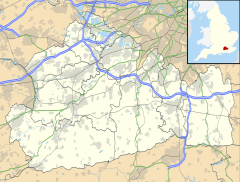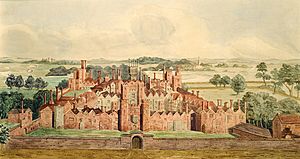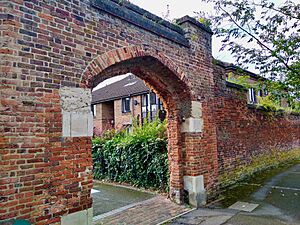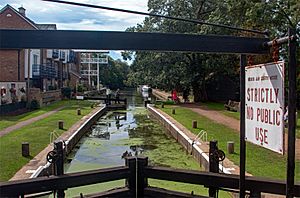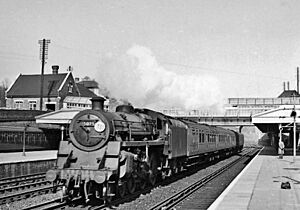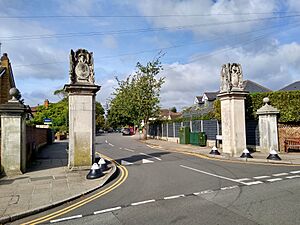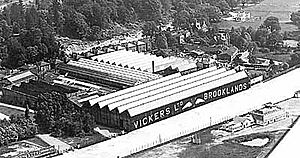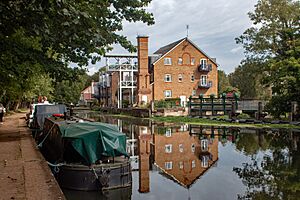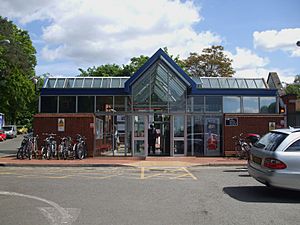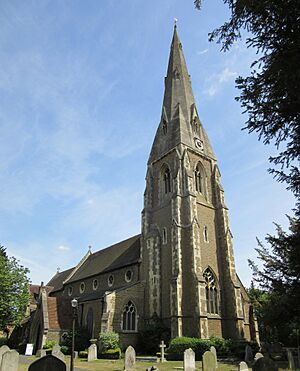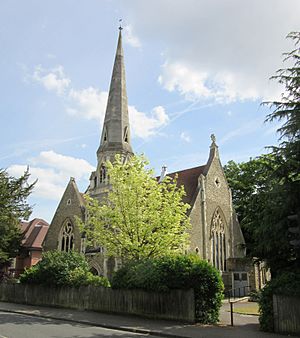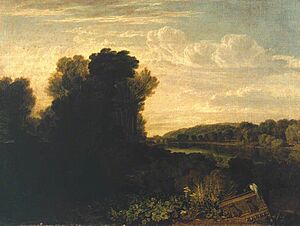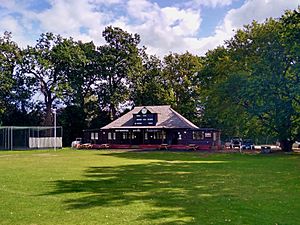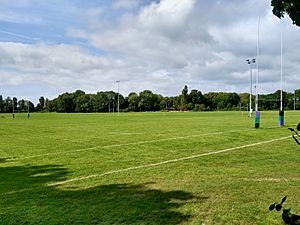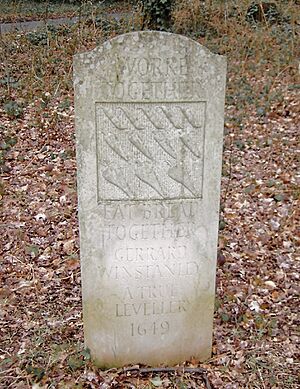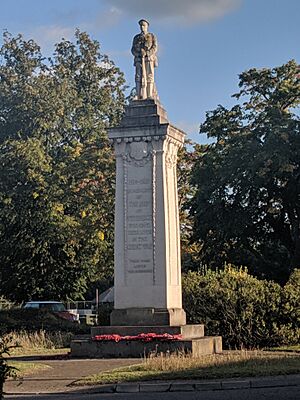Weybridge facts for kids
Quick facts for kids Weybridge |
|
|---|---|
| Town | |
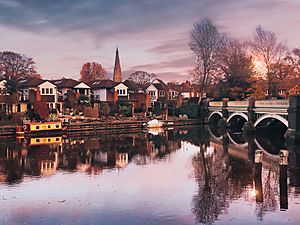 The Old Bridge on the River Wey |
|
| Area | 13.73 km2 (5.30 sq mi) |
| Population | 15,449 (2011 census) or 29,837 (Built-up Area, which extends to Byfleet) |
| • Density | 1,125/km2 (2,910/sq mi) |
| OS grid reference | TQ0764 |
| • London | 27 km (17 mi) north east |
| Civil parish |
|
| District |
|
| Shire county | |
| Region | |
| Country | England |
| Sovereign state | United Kingdom |
| Post town | Weybridge |
| Postcode district | KT13 |
| Dialling code | 01932 |
| Police | Surrey |
| Fire | Surrey |
| Ambulance | South East Coast |
| EU Parliament | South East England |
| UK Parliament |
|
Weybridge is a town in Surrey, England. It is about 27 kilometers (17 miles) southwest of central London. The town's name comes from a crossing point over the River Wey. This river flows into the River Thames north of the town center. People have lived here since the Bronze Age. In 2011, Weybridge had a population of 15,449.
In the 1530s, Henry VIII built Oatlands Palace nearby. He intended it for his fourth wife, Anne of Cleves. He later married Catherine Howard there. The palace was a royal home until the English Civil War. It was torn down in the 1650s. A new house, Oatlands House, was built later. Prince Frederick, Duke of York and Albany owned it in the 1700s.
Weybridge started to grow in the early 1800s. This happened when the Oatlands House estate was divided. Also, Weybridge Heath became private land. The railway station opened in 1838. A developer named Walter George Tarrant built many homes. These were on St George's Hill in the early 1900s.
The world's first special racing track was built at Brooklands in 1907. It hosted the first British Grand Prix in 1926. Malcolm Campbell used it to test his land speed record car. Brooklands was also important for making airplanes. Planes like the Sopwith Camel and the Wellington bomber were developed there. Vickers opened a factory in 1915. Aircraft making continued until 1988.
Contents
Exploring Weybridge's Past
The name "Weybridge" first appeared in writing in the 600s. It was called Waigebrugge or Weibrugge. This simply means "Bridge over the River Wey."
Oatlands was first mentioned in 1383. Its name might mean the area was used to grow oats. Brooklands was first recorded in 1548. Its name likely means "marshy land." St George's Hill got its name in the early 1600s. It used to be called Le Bery or Oldebury. This older name might refer to an Iron Age fort on the hill.
Weybridge's Location and Landscape
Weybridge is in northwest Surrey. It is about 27 kilometers (17 miles) southwest of central London. The town center is where the River Wey meets the River Thames. The town also includes St George's Hill and Brooklands to the south.
The highest point in Weybridge is 78 meters (256 feet) above sea level. Areas near the rivers are much lower, about 10-20 meters (33-66 feet) high. Nearby towns include Shepperton, Walton-on-Thames, Wisley, and Addlestone.
Early Human Activity in Weybridge
People first lived in Weybridge during the Bronze Age. In 1912, weapons like axe heads were found in the River Wey. Many ancient burial urns were also found in the 1800s and 1900s. Some urns found on the Silvermere estate contained bones and charcoal.
A copper bucket from northern Italy was found at Brooklands in 1907. During the Iron Age, there was a fort on St George's Hill. It covered about 14 acres (5.7 hectares). Most of the fort was destroyed when houses were built. Remains of a roundhouse were found in 1981.
There was not a large Roman presence in Weybridge. However, 68 Roman bronze coins were found at Brooklands in 1907. Many of these coins were given to the British Museum.
How Weybridge Was Governed
The Domesday Book mentions Weybridge three times. It shows land owned by Bishop Odo of Bayeux and Chertsey Abbey. No church or mill was recorded then.
A chapel was mentioned in 1176. By 1262, Newark Priory could appoint a priest and collect taxes. In 1284, Geoffrey de Lucy held the village.
After the dissolution of the monasteries, Weybridge became property of the Crown in 1537. Henry VIII started building Oatlands Palace that year. He used stones from Chertsey Abbey for its foundations. The palace was meant for Anne of Cleves, but their marriage ended. Henry married Catherine Howard there. The palace was a royal home until the Commonwealth period. Then, its contents were sold, and the buildings were torn down. Only a side entrance gate and some walls from around 1545 remain.
Over time, local administration changed. The parish church's vestry managed daily town affairs. This included helping the poor and maintaining roads. In the 1800s, new boards took over these tasks.
In 1894, the Weybridge Urban District Council (UDC) was created. It met in Aberdeen House from 1908. In 1932, Weybridge and Walton UDCs combined. In 1974, this combined council merged with Esher UDC. This formed the Elmbridge Borough Council.
Travel and Communication in Weybridge
The name "Weybridge" suggests a bridge over the River Wey since Anglo-Saxon times. In the Elizabethan era, it was a 240-foot (73-meter) wooden bridge. The current bridge, made of brick and stone, dates from 1865. A second bridge, for the A317 road, was finished in 1945.
Both the Thames and Wey rivers have been used for transport for a long time. By the 1300s, there was a wharf at Weybridge for timber. In 1537, building materials for Oatlands Palace came by river. The River Wey Navigation was approved in 1651. It involved building 12 locks and 9 miles (14 km) of new canals. Thames Lock was rebuilt in the 1930s.
Improvements to the River Thames near Weybridge began in the 1700s. Sunbury Lock opened in 1789 and Shepperton Lock in 1813. These locks helped control the river's flow and depth. The Desborough Cut opened in 1935. This 100-foot (30-meter) wide channel bypasses a 3-mile (4.8 km) river bend. It helps prevent floods and created Desborough Island.
The station at Weybridge opened in May 1838. It was in a deep cutting. A trip to London took about an hour. A line to Chertsey was built in 1848. The lines were electrified in 1907. Steam trains still ran through Weybridge until 1967. The station building was destroyed by fire in 1987.
A manual telephone exchange opened in Weybridge in 1912. It was replaced by an automated one in 1954.
How Weybridge Grew with Homes
In the early 1700s, Weybridge was a small village. Many rich families lived there. Two large estates dominated the area: Portmore Park and Oatlands Park. Oatlands Park was bought by Prince Frederick, Duke of York and Albany in 1790.
Weybridge started to grow in the late 1700s. In 1800, Weybridge Heath became private land. The Duke of York bought most of St George's Hill. Hanger Hill was laid out, and plots were sold for houses.
The Duke of York sold Oatlands Park in 1824. The rest of the Oatlands estate was sold in parts until 1846. House building began quickly, helped by the railway station opening in 1838. Most houses in Oatlands village were finished by 1859.
The west side of Weybridge High Street developed in the 1880s. This was when the Portmore Park estate was divided. Walter George Tarrant developed St George's Hill. He bought 936 acres (379 hectares) in 1911. He built the Tennis and Golf Clubs and advertised houses. Strict rules were put on the development. Building stopped during World War I and the Great Depression.
The first council houses were built by Weybridge UDC from 1923 to 1927. After World War II, over 1000 houses were built by the Weybridge and Walton UDC.
Brooklands: Racing and Aviation History
Brooklands, the world's first purpose-built motor-racing track, opened in 1907. It was built on farmland south of Weybridge. The concrete track was 2.75 miles (4.43 km) long. Car races started in July 1907, and motorcycle races in February 1908. The British Automobile Racing Club held regular races.
Motor racing stopped during World War I and resumed in 1920. The first two British Grand Prix races were held here in 1926 and 1927. In the early 1930s, Malcolm Campbell tested his land speed record car, the Campbell-Railton Blue Bird, at Brooklands. Racing stopped again at the start of World War II.
Brooklands was also key for British aviation. In 1907, A. V. Roe made the first flight by a British-built airplane here. By 1912, flying schools were set up. The Vickers company started making aircraft in 1915. The Sopwith Camel was one plane developed during World War I.
Aircraft continued to be made in the 1920s and 1930s. Barnes Wallis designed the Wellington bomber at the Vickers factory. The Hawker Aircraft company opened a factory in 1935. They built prototypes of the Hurricane fighter. During World War II, aircraft making increased. New factories were built, covering parts of the racing track. After 1945, the track was too damaged for racing to restart.
In the late 1940s, factories at Brooklands started making civilian airliners. Vickers produced the VC series, like the VC1 Viking. The VC10 was launched in 1964. The company became nationalized as the British Aircraft Corporation (BAC). BAC began focusing on making aircraft parts. Components for the British-built Concorde were made here. In 1977, BAC merged to form British Aerospace. Aerospace manufacturing in Weybridge ended in 1988.
Businesses and Factories in Weybridge
Watermills have been important in Weybridge's economy for a long time. The first record of a mill is from 1693. It was a paper mill where the Wey and Thames rivers meet.
Ironstone was dug from Weybridge Heath and St George's Hill. Iron was melted at a mill on Whittet's Ait in the late 1600s and early 1700s. This mill was also used for making brass wire.
A mill for grinding malt was built around 1819. In 1842, a new mill for extracting vegetable oil from seeds was built on the same site. Whittet's Ait mill was also used for this purpose. In the 1970s, Whittet's Ait had a solvent refinery.
For much of the 1900s, Weybridge was a center for the aerospace industry. The Lang Propeller Works opened in 1913. Vickers took over the Itala motor works at Brooklands in 1915. Other aircraft makers like Avro and Sopwith were also based there.
As of 2021, the European headquarters of Sony and the UK headquarters of Procter & Gamble are at Brooklands.
Weybridge During the World Wars
At the start of World War I, Weybridge became a training base. The 244 Motorised Transport Company, an army unit, trained here. They served in the Gallipoli and Balkans campaigns. Two military hospitals opened in Oatlands.
Ethel Locke King helped set up 15 hospitals in the area during World War I. She also organized a rest station for troops at Weybridge railway station. She was honored for her work in 1918.
The Vickers aircraft factory made Weybridge a target in World War II. The Home Guard defended the town. The local civil defense headquarters were in Aberdeen House. A large air raid shelter was built. Serious bombing began in August 1940. By December, 97 people had died, and 1300 houses were damaged.
A big air raid hit the Vickers plant in September 1940. Eighty-three people were killed. A 500-pound (230 kg) bomb landed but did not explode. Five Canadian engineers safely removed it. Lieutenant John Patton received the George Cross for his bravery. Later, 19 V-1 flying bombs landed in the Weybridge area.
Life in Weybridge Today
Public Transportation
Weybridge railway station is south of the town center. South Western Railway manages it. Trains go to London Waterloo and Woking.
Buses connect Weybridge to nearby towns and villages. Operators include Arriva, Diamond Bus, and Falcon Buses.
River Travel
The non-tidal part of the River Thames can be navigated from Lechlade to Teddington Lock. The Environment Agency manages this. The River Wey is navigable from Weybridge to Godalming. The National Trust manages the River Wey Navigation.
Cycling and Walking Paths
National Cycle Route 4, which links London to Fishguard, goes through Weybridge. The Thames Path is a long-distance walking trail. It runs along the south bank of the River Thames, north of the town center.
Town Services
Weybridge got its first drinking water in 1869. Water was taken from the Thames at Walton. Today, Affinity Water supplies drinking water.
The first wastewater treatment works opened in 1895. The current works opened in 1973. Treated water goes into the River Wey.
The Walton upon Thames and Weybridge Gas Company started in 1869. It was taken over in 1936.
In 1890, Weybridge was the first town in Britain to have electric street lighting. The power station in Church Walk operated for six years. A new station opened in Thames Street in 1902. From 1922, electricity came from the Twickenham and Teddington Electricity Supply Company.
Emergency Services
Weybridge Fire Brigade started in 1874. It had a horse-drawn engine. In 1881, it moved to a new building. A steam fire engine was bought in 1902. In 1921, Weybridge fire brigade also covered Cobham. The fire brigades merged in 1933. Weybridge Police Station opened in 1908 and closed in 1968.
Today, Surrey Fire and Rescue Service provides fire services. South East Coast Ambulance Service runs ambulance services. Surrey Police is the local police force. The nearest police station is in Esher.
Healthcare
Weybridge Cottage Hospital opened in 1889. A new hospital replaced it in 1928. It became part of the National Health Service in 1948. A new hospital opened next to the old one in 1999. In July 2017, the building was destroyed by fire.
The nearest hospital with an A&E is St Peter's Hospital, Chertsey. It is about 4.8 kilometers (3 miles) from Weybridge. The town has two GP practices in the Health Centre on Church Street.
Learning and Education
Schools in Weybridge
The first school in Weybridge was a Dame School around 1650. A charity school for poor children started in 1732. It became part of a new Parochial School in 1813. Another small school opened in Oatlands in 1862.
Weybridge has several Primary Schools. St Charles Borromeo Catholic Primary School opened in 1881. Cleves School became an academy in 2010. St James Church of England Primary School is in Grotto Road.
Heathside School is a co-educational secondary school for ages 11 to 18. It opened in 1966.
Independent Schools
St George's College Junior School is a Catholic school for ages 3 to 11. It moved to Thames Street in 2000. This site used to be a girls' school.
Further Education
Brooklands College opened in 1951. Its Weybridge campus is built around Brooklands House. This building was once the home of the Locke-King family. The mansion was rebuilt in 1891.
Brooklands College merged with Spelthorne College in 2007. It now has two campuses and teaches over 1,600 students. It offers Higher education courses with Oxford Brookes and Kingston Universities.
Places of Worship
Early Churches
The Domesday Book does not mention a church in Weybridge. The first record of a chapel is from 1175. During the Reformation, valuable items were taken from the church. The font was buried to protect it.
Major repairs were done in 1722. The church was demolished in 1848 and replaced by the present St James'. A piece of a fresco from the old church is now in Elmbridge Museum.
St James' Church
The Anglican parish church of St James was built in 1848. It was designed by John Loughborough Pearson in the Gothic Revival style. It is made of stone with a tiled roof. The spire was finished in 1855. The chancel is decorated with red and gold mosaics. In 1875, the church got eight bells.
Some monuments from the medieval church were moved to St James'. The oldest is a sculpture of three skeletons from around 1450. There are also two brasses from the time of Elizabeth I.
St Charles Borromeo Catholic Church
A Catholic Chapel was built on Weybridge Heath in the 1830s. It was for the Taylor Family and dedicated to St Charles Borromeo. Louis Philippe I, King of France, attended mass here after he left France in 1848. He and ten family members were buried in the crypt. Their bodies were later returned to France.
A church next to the chapel was built in 1880. It was the local Catholic Church until 1989. Then, the congregation moved to Christ the Prince of Peace Church. The old church was sold in 1993 and is now the World Mission Korean Presbyterian Church.
Christ the Prince of Peace Catholic Church
Christ the Prince of Peace Catholic Church opened in 1989. It replaced St Charles Borromeo and St Martin de Porres. Benches, statues, and the crucifix from the old churches were moved here.
Weybridge United Reformed Church
The Nonconformist community in Weybridge started in 1855. Benjamin Scott began holding outdoor services.
The foundation stone of Weybridge United Reformed Church was laid in 1864. The church, designed by John Tarring, opened the next year. It is made of stone with a square tower and spire.
St Mary Oatlands
St Mary Oatlands started as a chapel in 1867. Two years later, it became a church with its own parish. Extensions include the tower (1905) and the Chapel of the Resurrection (1920).
Weybridge Methodist Church
Weybridge Methodist Church was designed by Josiah Gunton. Its foundation stone was laid in June 1900. The church was badly damaged by fire in 1977 but reopened in 1980.
North West Surrey Synagogue
The first Jewish group in Weybridge met in the late 1930s. North West Surrey Synagogue was founded in 1968. It moved to new places in 1981 and 1985. In 2021, the synagogue is part of the Movement for Reform Judaism.
Arts and Entertainment
Art in Weybridge
The Thames at Weybridge, painted by J. M. W. Turner in 1805–06, is held by the Tate. The Elmbridge Museum has works by Charles Claude Houssard and Edwin Lock. Guildford House Gallery has two views of Weybridge by Winifred Schofield. Brooklands Museum has art about motor racing and aviation.
Weybridge in Books
Several authors have lived in Weybridge. George Meredith lived here from 1849. He wrote his first fiction book, The Shaving of Shagpat, here. The French novelist Émile Zola lived at the Oatlands Park Hotel from 1898 to 1899. E. M. Forster lived at 19 Monument Green from 1904 to 1912. He wrote all six of his novels during this time. A plaque marks his former home. The novelist Warwick Deeping lived on Brooklands Lane from 1918 until his death.
Weybridge is mentioned in several books. In H. G. Wells' The War of the Worlds (1897), a Martian falls into the River Thames near Weybridge. In John Wyndham's The Kraken Wakes (1953), characters are stopped in the "Staines-Weybridge area." Salman Rushdie's The Satanic Verses (1988) also mentions Weybridge.
Music in Weybridge
The rock band, You Me at Six, formed in Weybridge in 2004. Four members went to Brooklands College. Local choirs include the Treble Clef Choir and the Weybridge Male Voice Choir.
Sports and Fun Activities
Cricket
Weybridge Cricket Club formed in 1924. Cricket has been played on Weybridge Green since at least 1814. The ground was improved in 1921.
Weybridge Vandals Cricket Club started from two clubs formed in the early 1900s. Brownacres Cricket Club changed its name to University Vandalls CC in 1953. It merged with Olinda CC in 1975.
Golf
St George's Hill Golf Course was designed by Harry Colt. The first 18 holes opened in 1913. The original clubhouse burned down in 1920 and was replaced. Edward VIII was president of the club. A second 18-hole course opened in 1929.
Silvermere Golf Course opened in 1976. It has 18 holes around Silvermere Lake. Barnes Wallis tested his bouncing bomb prototypes here. Golfers must hit the ball across the lake on two holes.
Rowing
Weybridge Rowing Club was founded in 1881. It moved to its current location in 1910. Women were allowed to join in 1910. Weybridge Ladies Amateur Rowing Club was founded by Amy Gentry in 1926. Weyfarers Rowing Club started in 2000 for recreational rowers.
The Weybridge Community Regatta happens on the Desborough Cut each summer. The club also hosts the Weybridge Silver Sculls head race. This race is 3000 meters (3280 yards) long on the Thames.
Rugby
Weybridge Vandals RFC was founded in 1932. It was first called "London University Vandals RFC." The club moved to Desborough Island in 1932. In 2003, it changed its name to Weybridge Vandals RFC.
Tennis
St George's Hill Lawn Tennis Club opened in 1913. It has 33 courts, including 13 grass courts. It also has squash courts and facilities for badminton and table tennis.
Weybridge Lawn Tennis Club has five outdoor courts.
Places to Visit
Brooklands Museum

Brooklands Museum opened in 1991. It is on 30 acres (12 hectares) of the former Brooklands site. The museum has preserved historic buildings. It displays many old aircraft, racing cars, and motorcycles. These include Concorde G-BBDG and a Wellington Bomber.
London Bus Museum
The London Bus Museum started in the mid-1960s. It moved to the Brooklands Museum site in 2011. About 30 buses from the 1820s to the 1970s are on display. Entry to this museum is with a combined ticket for Brooklands Museum.
Mercedes-Benz World
Daimler AG bought the former Brooklands runway in 2002. The northern part became Mercedes-Benz World, which opened in 2006. The southern part became Brooklands Community Park. The racing circuit section was restored. Mercedes-Benz World has historic cars and offers driving experiences.
Important Buildings and Landmarks
Memorial to Gerrard Winstanley
A memorial to Gerrard Winstanley was unveiled in December 2000. It is near the railway station. Winstanley was a leader of the Diggers, a group from the 1600s. They set up camp on St George's Hill in 1649. They wanted to farm common land. The Diggers were forced to leave by 1650.
Oatlands Park Hotel
After Oatlands Palace was torn down, the land changed owners. Henry Clinton, 7th Earl of Lincoln inherited it in 1716. He built a new house in 1725. Prince Frederick, Duke of York and Albany bought it around 1790. Much of the house was destroyed by fire in 1794. A new mansion, Oatlands Park, was designed by Henry Holland. It was built in the Italianate style.
The Duke of York sold Oatlands Park in 1824. The land was sold in 1846. In 1856, Oatlands Park became a hotel.
The 10-hectare (25-acre) Broad Water, or Broadwater Lake, is near the Oatlands Park Hotel. It was a canal in 1737 and enlarged by 1770. The lake looks like it flows under Walton Bridge. A new footpath along the lake opened in 2017.
Ship Hotel
Parts of the Ship Hotel on Monument Green may be from the 1500s. Its name might come from "shippin," meaning a cattle shed. In the 1700s, the inn was used for court meetings. During the Napoleonic Wars, it was a recruiting center for the army.
War Memorial
The war memorial was built in 1923. It is at the south end of Monument Hill. It has a statue of a soldier. It remembers 224 people who died in World War I, World War II, and the Korean War.
Yool Memorial
The stone drinking fountain was built in 1896. It is at the junction of Hanger Hill and Princes Road. It honors Henry Yool, a local helper. It was moved to its current spot in 1971.
York Column
The York Column on Monument Green used to be in central London. It was a sundial pillar from the 1690s. It was taken apart in 1777. The stones were bought by James Paine. In 1822, it was put up in Weybridge. It is a memorial to the Duchess of York. The old dialstone is now near Weybridge Library.
Parks and Green Spaces
Brooklands Community Park
The 24-hectare (59-acre) Brooklands Community Park opened in 2006. It was given by Daimler AG to Elmbridge Borough Council. It has a playground, multi-use games area, skatepark, and off-road cycle course. The rest of the park is natural grassland. It is home to plants and butterflies. Brooklands Parkrun happens here on Saturday mornings.
Churchfields Recreation Ground
Churchfields recreation ground opened in 1908. It was on land given by John Lyle.
Monument Green
Monument Green is a common land area. It is at the north end of the High Street. In the 1700s, it was called the "Bull Ring." The village pump was here in the early 1800s. The York Column was put in the center in 1822. Most houses around the green were built in the late 1800s and early 1900s.
Weybridge Heath
Weybridge Heath is south of the town center. It was set aside for local residents in 1800. Elmbridge Borough Council owns about 16.6 hectares (41 acres) of it.
Whittet's Ait
Whittet's Ait is an island between the River Wey and River Wey Navigation. It is named after the owner of an old oil seed mill. Elmbridge Borough Council bought the public land on the island in 2000. This was to protect it for recreation.
Famous People from Weybridge
- Thomas Hopsonn (1643–1717) – A Vice-admiral, moved to Weybridge in 1702.
- David Colyear, 1st Earl of Portmore (around 1656–1730) – An army officer, lived at Portmore Park.
- Fanny Kemble (1809–1893) – An author and anti-slavery campaigner, lived at Eastlands.
- Benjamin Scott (1814–1892) – A Chamberlain of the City of London, founded the Congregational chapel.
- George Fergusson Wilson (1822–1902) – An industrial chemist, lived in Weybridge from 1863.
- Lionel Smith Beale (1828–1906) – A physician, lived in Weybridge from 1885 to 1904.
- Elizabeth Dawes (1864–1954) – A classical scholar, lived and taught in Weybridge from 1889.
- George May, 1st Baron May (1871–1946) – A financial expert, lived at Eyot House.
- Frank Finlay (1926–2016) – An actor, lived in Weybridge.
- Colin Davis (1927–2013) – A conductor, was born in the town.
- Bernard Cribbins (1928-2022) - An actor, lived in Weybridge later in his life.
- John Fozard (1928–1996) – An aeronautical engineer, lived at St George's Hill.
- John Lennon (1940–1980) – A musician, lived at Kenwood, St George's Hill from 1964 to 1968.
- Cliff Richard (born 1940) - A singer, had his main home in Weybridge for some years.
- Ringo Starr (born 1940) – A musician, lived at St George's Hill from 1965 to 1968.
- Mike Yarwood (1941–2023) - An impressionist, lived in Weybridge after retiring in 2007.
- Jacqueline Bisset (born 1944) - An actress, born in Weybridge.
- Gilbert O'Sullivan (born 1946) - A singer-songwriter, lived in Weybridge in 1973.
- Theo Paphitis (born 1959) – A businessman and TV personality.
- Bernie Nolan (1960–2013) – A singer and actress, lived in Weybridge.
See also
 In Spanish: Weybridge para niños
In Spanish: Weybridge para niños


